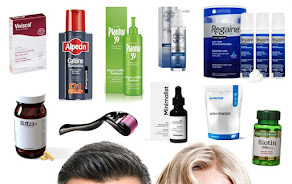The negative side effects of minoxidil hair loss treatment
There are very few medically approved hair loss treatments, and minoxidil is one of them. In fact, minoxidil is still the only medically approved topical hair loss treatment for men (5% solution) and women (2% solution).
The problem is, like with any drugs and medications you take, there is the risk of negative side-effects, and some of which can be quite serious.
In this article, we take a look at all of the reported negative side effects of minoxidil, from common to rare, and mild to severe.
Firstly, what is minoxidil?
Minoxidil, sold under the brand name Regaine/Rogaine among many others, is a medication used for the treatment of high blood pressure and pattern hair loss. It is an antihypertensive vasodilator. It is available over the counter as a topical liquid or foam.
Although results tend to be quite minimal, minoxidil has shown to help with the prevention of hair loss, the stimulation of hair growth, and hair regrowth, in some cases.
What are the side effects of minoxidil?
Unfortunately, using minoxidil comes with its risks. Negative side effects from using minoxidil are relatively common, with some being quite severe. However, the majority of male and female users only experience mild side effects from using the solution.
Here are all of the reported negative side effects of minoxidil...
Skin rash
Some users reported spots, acne, and skin rash in and around the hairline, scalp, and facial skin, from using the minoxidil treatment. These symptoms tend to be temporary, but they can be longer lasting for some users.
Itching on the scalp
Some users have reported excessive itching and irritation on the scalp from using minoxidil. This can sometimes lead to a burning sensation, which can sting. Again, this usually occurs during initial use, but clears away in most cases.
Facial hair growth
Male and female users have reported growth of facial hair during their usage of minoxidil. This may not be an issue for men, but it can be a serious issue for female users.
Increased hair loss
Many users of minoxidil have reported excessive hair shedding, particularly during early stages of use. This does tend to be temporary, but it can be long lasting in some users.
Reddened skin
Continuous use of minoxidil can cause redness on the skin. This is normal during early usage, but if it doesn't clear away, it can be a serious issue.
Swelling of the face
Some patients have reported swelling and puffiness on the face from using the minoxidil treatment. This is not particularly common.
Blurred vision
A more serious side effect of minoxidil is blurred vision and other changes in vision. This is a result of too much medication being absorbed into the body.
Chest pain
Chest pain, and general tightness around the cheat area are common side effects that are associated with using minoxidil. If this occurs, see a doctor immediately.
Headaches and dizziness
Many users, especially during early stages of treatment, reported having headaches, as well as feeling dizzy. This is quite common, but it usually clears away as the body adapts to the medication.
Fainting
It's rare, but some users fainted from using the minoxidil treatment. If this happens, be sure to come off the treatment and seek medical advice.
Irregular heartbeat
Heart issues, such as fast or irregular heartbeat, are serious side effects of using minoxidil, and therefore you should seek urgent medical advice if this happens to you.
Numbness and tickling sensation
Many male and female users reported numbness and tickling sensations in their hands and feet. Some users reported constant pins and needles in their limbs. If these symptoms do not go away, come off the treatment and seek medical advice.
Swelling of ankles
One of the more serious side effects associated with minoxidil is the swelling of the ankles. The ankles can increase in size, looking puffy and swollen.
Rapid weight gain
Putting on weight is a common side effects of using minoxidil, particularly with female users. This can be a rapid process, and long term, too.
If any of these negative side effects occur, either lower the dosage or come off the drug completely, and seek safe, non-medical alternatives.
What is the safe, non-medical alternative to minoxidil?
There doesn't appear to be many non-medical topical solutions for hair loss that are as effective as minoxidil, however, keratinocyte growth factor (KGF) is often seen as the best and most effective alternative.
This powerful formula works particularly well when used as a topical serum, and has shown to help prevent excessive hair loss, and promote the function of healthy hair growth.
KGF is safe to use, with no risk of any major negative side effects.









Post a Comment